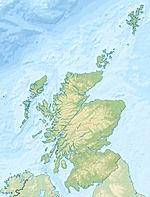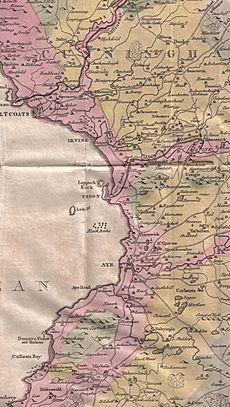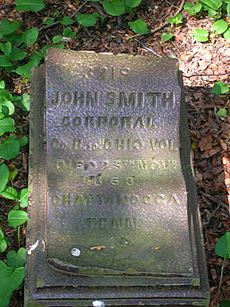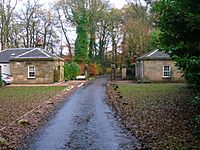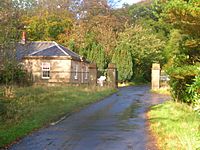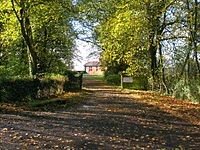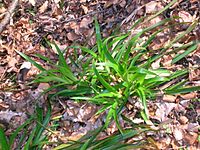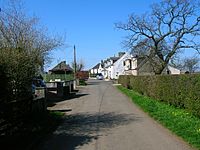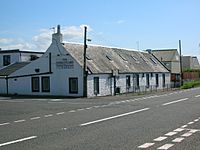Montgreenan facts for kids
Quick facts for kids Montgreenan |
|
|---|---|

Montgreenan House
|
|
|
Listed Building – Category A
|
|
| Designated | 14 April 1971 |
| Reference no. | LB7577 |
| Lua error in Module:Location_map at line 420: attempt to index field 'wikibase' (a nil value). | |
Montgreenan is an estate in North Ayrshire, Kilwinning, Scotland. A river called the Lugton Water flows through its lands. Close by are the small villages of Torranyard and Auchentiber.
Contents
The Story of Montgreenan Lands
The name 'Grenane' was first written down in 1480. We learned more about Montgreenan from Timothy Pont between 1604 and 1608. He described 'Mongrynen Castle' as an "old strong Dunijon" (a type of castle). It was owned by the Cunninghame family.
In the 1400s, the Ross family owned the Montgreenan land. They owned many other lands in Ayrshire, like Dunlop. The Rosses were loyal to the De Morvilles, who were powerful lords.
| What Does Montgreenan Mean? |
| Montgreenan means 'Mound of the Sun' or 'Sunny Mound'. It can also mean 'Hill of the Hall or Palace.' |
After King James III of Scotland was killed, Sir John Ross de Montgreenan lost his lands. But he quickly got them back under King James IV. The land then went to the Monastery of Kilwinning.
Later, in 1582-83, Alexander Cunninghame and his wife Jean Blair took over the lands. Alexander was a strong supporter of the Reformation, a time of big changes in the church.
A Sad Event at Montgreenan
On August 1, 1586, Alexander Cunninghame was shot and killed at his gate at Montgreenan. Sir Robert Montgomerie of Skelmorlie was responsible. This happened because of a previous killing of Hugh Montgomerie, 4th Earl of Eglinton.
Lady Jean Cunninghame passed away in 1621. Her son William then owned the lands. By 1632, her grandson Alexander Cunninghame was the owner. His son Thomas took over in 1656.
Thomas's son, also named Thomas, fought in the Battle of Bothwell Bridge. He was sentenced to death but his life was saved. However, his lands were taken away and given to Lieutenant-General Douglas. Douglas then sold the land to High Stevenson.
In 1691, records show the main house had seven fireplaces. There were also five other homes on the 'Lands of Montgreenan'.
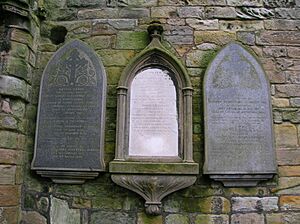
The Stevenson family owned the estate until 1778. They sold it to John Bowman. He then sold it to Dr. Robert Glasgow. Dr. Glasgow married Rachel Dunlop, but they had no children. He died in 1827. His funeral was known for how much help was given to 616 poor people in the area.
Mrs. Rachel Glasgow was an artist and writer. She died in Pau, France, in 1828. The poet Robert Burns mentioned her in a poem. Mrs. Glasgow gave £200 to the poor of Kilwinning. A well was built in her honor.
Robert Robertson, a relative, inherited the estate. He changed his last name to 'Glasgow'. His son, Robert Robertson Glasgow, inherited it in 1845. Then his son, Robert Bruce Robertson Glasgow, took over in 1860.
Later Owners of Montgreenan
In 1873, R. B. Robertson-Glasgow was a Lieutenant-Colonel in the Royal Scots Fusiliers. Later, in 1896, R. P. Robertson-Glasgow also commanded a battalion of the same army group.
Sir James Bell, a shipowner and former leader of Glasgow, bought the estate in 1895. He was the Chairman of the Glasgow and South Western Railway from 1915 to 1920. He died at Montgreenan in 1929.
The Old Castle or Bishop's Palace
The old Montgreenan Castle, sometimes called the Bishop's Palace, is now in ruins. It sits where the Lugton Water river meets the Cowlinn Burn. A nearby woodland is called Dunach Brae. This name suggests there might have been an old hill fort, or 'Dun', there long ago.
In 1895, John Smith wrote that "little appears to be known" about the ruins in Montgreenan Woods. Near the ruins, there is part of an old gateway. South of the main house, there are remains of a mound that once held an ice-house.
Today, only a small piece of wall remains by the stream. There is also a slight dip in the ground, surrounded by a bank of old wall rubble. Mr. R. Glasgow, the owner in 1856, said the building was probably no longer used after 1680. Much of its stone was removed around 1765 by Mr. Stevenson to build a house in Kilwinning.
In 1956, a visit found traces of buildings hidden by thick plants. The castle seemed to have a courtyard with buildings on all sides except the east. This type of building with a central courtyard was called a 'Place' or 'Palace'. All the walls were just piles of stones. There was no clear proof that it was a "Bishop's Palace."
About 65 meters (213 feet) south, there was a mound 1.5 meters (5 feet) high. A track had cut through it. This might be the ice-house that Smith mentioned, but no stone parts are left. No sign of a gateway was found.
Pictures of Montgreenan Castle in 2007
The Grand Montgreenan House
The current large house was built in 1817 by Sir Robert Glasgow. It has special designs by Alexander 'Greek' Thompson. Sir Robert made his money through a shipping company in St Vincent in the West Indies. This company likely traded between Britain, Africa, and the sugar plantations.
Montgreenan was the home of the Viscounts Weir until 1982. Then, it was sold and became a hotel. The building is considered a very important historical building by Historic Scotland.
Alexander Craufurd of Fergushill inherited Fergushill from his father. It then passed to the Kincaid family. In 1728, Neil Macvicar and his wife Elizabeth Montgomerie bought the lands. The Macvicars owned them until 1802. Robert Glasgow of Montgreenan then bought them.
Archibald Stevenson bought Montgreenan in 1755. He sold it to Mr. Bowman in 1778. Mr. Bowman was a leader in Glasgow and built Ashgrove House.
The estate once had a curling pond, a large stable, offices, a main farm, and a walled garden. These buildings are still used as private homes today (2008). Caven Mill was probably the local mill where tenants had to grind their grain. This building is now a ruin.
A Soldier's Memorial
Near the old castle ruins, there is a special memorial stone. It looks like a decorative stone used on walls. It has cannons crossed at one end and olive or laurel leaves at the other.
The writing on it says: "3219 – John Smith – Corporal – Co. B. 10th Ohio Vol – Died 25th Novr – 1863 – Chattanooga – Tenn". This means John Smith was a Corporal in the 10th Ohio Volunteers. He died fighting in the Chattanooga Campaign in November 1863. Since he was in the Ohio Volunteers, he fought for the Union side in the American Civil War. It seems John Smith had a strong connection to the Montgreenan estate.
The Montgreenan Milestones
Along the driveways leading to the Montgreenan house, you can see red sandstone pillars. These are old milestones. They look like gateposts. They were saved when roads were made wider or changed. They come from different places in Ayrshire.
Sir James Bell of Montgreenan enjoyed collecting milestones and other old stones. Many Ayrshire milestones were buried during World War II to hide them in case of an invasion. Two milestones are near the West Lodge, and three are near the East Lodge at Montgreenan Mains.
-
A Kilmarnock to Dundonald milestone at the entrance to Montgreenan Mains.
The Old Montgreenan Carriageway
Maps from 1858 show an old carriage road. It ran from near the Auchentiber schoolhouse, through the Montgreenan forests. It crossed a road near Cavan Mill and went down to Montgreenan house.
Another path and later a road ran from Auchenharvie Castle. This route went under the Montgreenan carriageway using a bridge. The area near the old Mosside farm had several limestone quarries and limekilns in 1858. But by 1897, these had closed.
The Mosside bridge is very well-built and decorated. It has fake windows, diamond shapes, and a thistle on its main stone. It also has patterns that look like leaves.
Old papers say the fake windows were for a family crest. The old coach road used this bridge to go towards Cavan Mill and beyond.
Pictures of Mosside Bridge and Carriageway
Montgreenan Railway Station
The Glasgow and South Western Railway built a station at Montgreenan. It opened on February 1, 1878. It stopped serving passengers on March 7, 1955. The old station building is now a private home. The house near the old entrance was once a home for the minister of the old Fergushill church. It was also used by the railway company for their agent.
Nature at Montgreenan
The Old Wood area has many different kinds of plants and animals. In 2007, some plants found there included Woodruff, Bird cherry, Primrose, Common violet, Oak, and Bluebell. You can also find Greater Woodrush, Dog's mercury, and various ferns. There are also many liverworts, which are small green plants. Several badger homes, called setts, are also present.
Old Stories and Finds
It is said that a large amount of treasure from Kilwinning Abbey was found at Montgreenan around 1740. The treasure included seven pots of coins, rings, necklaces, and other valuable items.
A local story says that Alexander Cunninghame, who lived at Montgreenan, buried the treasure. He knew his life was in danger after the 4th Earl of Eglinton was killed. Alexander was killed at his home in 1586. People believed his ghost protected the treasure.
In 1895, John Smith wrote that a pot of silver coins was found in Chapel Park, on Montgreenan lands. We don't have other records of a chapel there before the Reformation, except for this field name.
Montgreenan's Local History
Old maps show that the village of Benslie was called 'Montgreenan' until at least 1938. The name Benslie was used for the nearby wood and an old farmhouse. The postal address might have been changed to avoid confusion with the Montgreenan estate.
Opposite Janburrow in Benslie is Burnbrae cottage. It was built in 1846 as the house for the Montgreenan Estate manager. Next to Burnbrae is Burnbank Cottage, built in 1882 for Mathew Kirkland, a former gamekeeper.
The ruins of Auchenharvie Castle are a clear landmark in the flat area of Torranyard.
Scientists have studied Bloak Moss to learn about its plant history. They did this by analyzing core samples from the moss.
South Fergushill church in Benslie was built to serve Montgreenan, Fergushill, Doura, and Benslie. It was officially opened on Sunday, November 3, 1879. The first minister was Rev. William McAlpine.
The Montgreenan coal mine was connected by a railway that ran through Sevenacres. It was closed before 1875.


